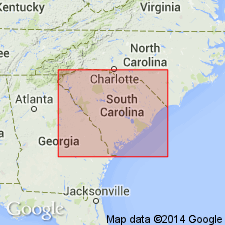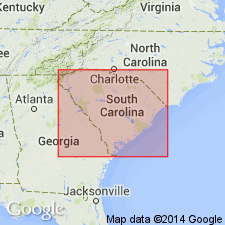
- Usage in publication:
-
- Chapel Branch Member
- Modifications:
-
- Named
- Dominant lithology:
-
- Limestone
- AAPG geologic province:
-
- Atlantic Coast basin
Summary:
The Chapel Branch Member of the Santee Limestone, here named, is a foraminiferal biomicrite lithofacies which crops out along the south shore of Lake Marion in Orangeburg and Calhoun Cos., SC. It consists of yellowish-gray, homogeneous matrix-supported foraminifers, ostracods, echinoids, and mollusks, with traces of bryozoa. It is laterally equivalent to other lithofacies in the Santee; grades downdip into bryozoan biosparrudite/biomicrudite facies and stratigraphically underlies the Caw Caw Member molluscan-mold mudstone facies. Thickness at type section is 7.5 ft (2.3 m). Age is middle Eocene.
Source: GNU records (USGS DDS-6; Reston GNULEX).

- Usage in publication:
-
- Chapel Branch Member
- Modifications:
-
- Geochronologic dating
- AAPG geologic province:
-
- Atlantic Coast basin
Summary:
Glauconitic micas from the Chapel Branch Member of the Santee Limestone yield Rb-Sr isochron dates of 40.4+/-0.8 Ma. This does not agree with the Rb-Sr glauconitic mica isochron date of 36.7+\-0.6 Ma reported by Harris and others (1984), now considered to be too young. Unit contains age diagnostic oysters and echinoids that allow correlation to the type Santee at Eutaw Springs and the upper Lisbon Formation of AL. It is considered to be late middle Eocene.
Source: GNU records (USGS DDS-6; Reston GNULEX).
For more information, please contact Nancy Stamm, Geologic Names Committee Secretary.
Asterisk (*) indicates published by U.S. Geological Survey authors.
"No current usage" (†) implies that a name has been abandoned or has fallen into disuse. Former usage and, if known, replacement name given in parentheses ( ).
Slash (/) indicates name conflicts with nomenclatural guidelines (CSN, 1933; ACSN, 1961, 1970; NACSN, 1983, 2005, 2021). May be explained within brackets ([ ]).

